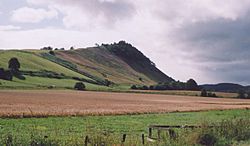Battle of Drumchatt (1501) facts for kids
The Battle of Drumchatt was a fight between Scottish clans that some historians say happened in 1501. It was supposedly fought near Strathpeffer in the Scottish Highlands. The battle was between the Clan Mackenzie and the Clan Munro. Stories from the Mackenzie clan claim they won a big victory. However, many historians are not sure if this battle really happened.
Quick facts for kids 'Mythical' Battle of Drumchatt (1501) |
|||||||
|---|---|---|---|---|---|---|---|
| Part of Clan Munro and Clan Mackenzie feud | |||||||
 Knockfarrel hill also known as the cat's back at Drumchatt where the clan battle is said to have taken place |
|||||||
|
|||||||
| Belligerents | |||||||
| Clan Mackenzie Clan Macrae |
Clan Munro Dingwall family Clan MacCulloch |
||||||
| Commanders and leaders | |||||||
| Hector Roy Mackenzie Duncan Mor Macrae |
William Munro | ||||||
| Strength | |||||||
| 140 or not exceeding 180 |
700 or 900 | ||||||
| Casualties and losses | |||||||
| Unknown | 19 "heads cut off" | ||||||
Contents
Was the Battle of Drumchatt Real?
The first time anyone wrote about the Battle of Drumchatt was in 1669. This was in a book called History of the Family of Mackenzie by George Mackenzie, 1st Earl of Cromartie. He described a battle between the Munros and Mackenzies in 1501.
However, many historians have been puzzled by this. There are no records of such a battle in any documents from that time. Later, in the late 1800s, another historian named Alexander Mackenzie also wrote about this battle. He was a direct descendant of Hector Roy Mackenzie, who he said led the Mackenzies in this fight.
What Happened in the Battle?
According to the Mackenzie clan's stories, William Munro, 12th Baron of Foulis led a large group of 700 or 900 fighters. This group included Munros, Dingwalls, and MacCullochs. They supposedly attacked the Mackenzie lands, causing damage and taking cattle.
However, on their way back, they were attacked by a much smaller group of Mackenzies. Alexander Mackenzie said there were only 140 Mackenzies, while George Mackenzie said there were 180. This smaller Mackenzie force was led by Hector Roy Mackenzie of Gairloch. The fight supposedly happened at a place called Drumchatt.
Hector Mackenzie did not want to fight a large army head-on. Instead, he ambushed William Munro's force. They attacked when the Munros were marching in a long, spread-out line on the south side of Knockfarrel hill. This hill is part of the Drumchatt ridge.
George Mackenzie's account says the Mackenzies cut off many heads with axes and swords. He claimed that nineteen heads rolled down the hill into a well. This well has since been known in Scottish Gaelic as Tober ni Kean, which means the "Fountain of Heads". One source says that William Munro's sheriff, Alexander Vass of Lochslin, was among those killed.
A short Gaelic poem was also written about this battle by Rev. John MacRae. Alexander Mackenzie translated it as:
"Although MacRath doth "fortunate" import, It's he deserves that name whose brave effort, Eight hundred did put to flight, With his seven score at Knock-Farrel".
The Clan Munro Association (UK) translates the second part of the poem a bit differently:
'Did eight hundred men defeat and many kill, With his seven score on the face of Pharrel hill'.
A modern historian, Charles Ian Fraser, also mentions William Munro and this battle. He notes that William Munro was an important person in the north and was knighted by King James IV. Fraser says that in 1501, William Munro led a group of Munros, Dingwalls, and MacCullochs to attack Hector Roy Mackenzie at Druim-a-Chait. He also mentions that Mackenzie stories claim a big victory.
What Happened After the Battle?
William Munro, 12th Baron of Foulis, was later killed in 1505. This happened at the Battle of Achnashellach while he was working for the King, fighting against the Clan Cameron.
However, William Munro's son, Chief Hector Munro, 13th Baron of Foulis, later married Catherine Mackenzie. She was the daughter of Chief Kenneth Mackenzie, 7th of Kintail. According to historian Alexander Mackenzie, this marriage was a way to make peace between the clans after the Battle of Drumchatt in 1501.
In the year 2000, the leaders of the Clan Mackenzie and Clan Munro decided to call a truce. The Mackenzies even invited the Munros to join their clan gathering to remember the Battle of Druim a Chait. This shows how old rivalries can sometimes be put aside.
See also

